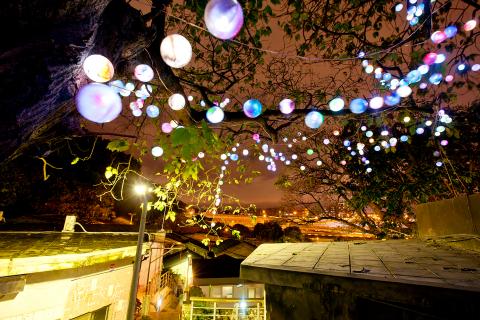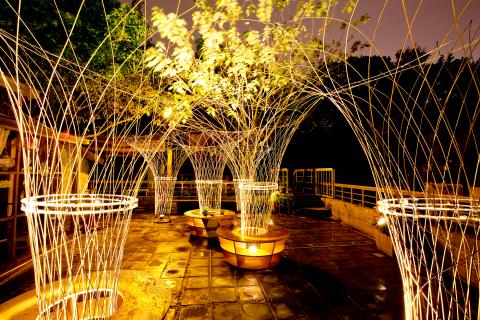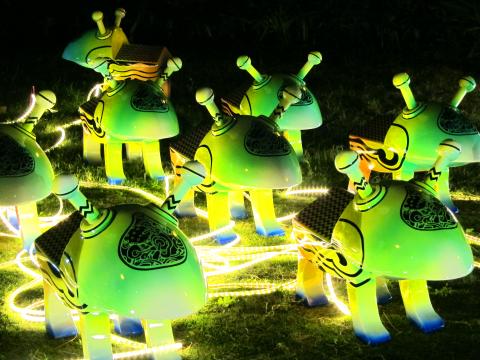Once a squatter community composed primarily of war veterans who retreated to Taiwan with the Chinese Nationalist Party (KMT) government, Treasure Hill Artist Village (寶藏巖國際藝術村) in Taipei’s Gongguan District (公館) has gradually been transformed into a weekend hot spot frequented by camera-wielding visitors, with a youth clubhouse, the latest addition to the artist village, slated to open later this year.
Now, the past and present transformations of the site are being explored with Landscape of Spectacle (如畫美景), a group exhibition that opened on the eve of the Lantern Festival last month as part of the Lunar New Year celebrations and is currently on display at Treasure Hill. It features works by 11 individual artists and groups using different media such as light, sound and found objects to express their heterogeneous ideas and feelings toward the historical community.
According to Hsiao Shu-wen (蕭淑文), director of the artist village, the inspiration for the exhibition comes from an art project completed in 2003 by visiting Finnish artist and architect Marco Casagrande, who envisioned the former veterans’ settlement as an “attic of the city where memories are stored,” Hsiao said, quoting the artist.

Photo Courtesy of Department of Artist-in-residence, Taipei Culture Foundation
“A decade later, Treasure Hill has become a cultural attraction,” the director said. “This is a site of historical and political significance. We are not here to criticize, but use art as a medium to explore the multiple meanings of the space.”
As exhibited art works are scattered in the labyrinth of piecemeal buildings built on the hill, visitors are encouraged to wander through the meandering alleys and narrow passageways to experience, contemplate and raise their own questions about the place, Hsiao added.
Located on a meadow near the village’s entrance, Out in Force (傾巢而出的漫遊) attracts attention with a large number of colorful light fixtures remodeled to resemble humans escaping from what appears to be a sinking house on the lawn.

Photo Courtesy of Department of Artist-in-residence, Taipei Culture Foundation
“We try to use a cute and somewhat comic way to respond to past incidents [that happedened at the village],” explained Lin Chien-yu (林建佑), one of the artists who made Out in Force.
Lin refers to Treasure Hill’s previous incarnation as an illegal settlement. Designated a historical site in 2004, the area went through renovations begun by the city’s Department of Cultural Affairs in 2007. Most of the tenants were relocated, and only 20 households of original residents remain in the community. The artist village was officially put into operation in 2010 under the management of Department of Artist-in-residence, Taipei Culture Foundation.
Whisper on Treasure Hill (集光片語) by architect and artist Chen Chien-chih (陳建智) further examines people’s relationship with their home through an architectural work composed of a structure made of bamboo and the scaffolding that encloses it. Walking through the scaffold structure and into the building hand-built by the artist and his assistant, visitors circumnavigate the building and arrive at the “inner room,” a space surrounded by bamboo and exuding a sense of calm. Along the way, hung light bulbs glimmer as they play the artist’s pre-recorded sounds out of tiny speakers. Each light tells a different story: one repeats the sounds coming from and elderly tenant’s television; another plays the bustling ambience of the community’s celebration in which former residents rejoined the villagers to host a year-end banquet.

Photo Courtesy of Department of Artist-in-residence, Taipei Culture Foundation
“The protagonists are the stories told by the lights in quiet murmurs. This piece expresses the idea that the preservation of a place should include all the people who live in it,” Chen said.
Other works such as The Solar — Treasure Hill Artist Village (日光浴–寶藏巖國際藝術村) by four-member art group LuxuryLogico (豪華朗機工) approach the historical settlement with lyrical, imaginative musing. Composed of more than 220 recycled street lamps, LuxuryLogico’s large-scale light installation is intended to simulate the sun or the moon appearing to rise over the hilly village.
“You can sit on the lawn facing Sindian River (新店溪) and contemplate the luminary as it waxes and wanes,” said LuxuryLogico’s Chang Keng-hau (張耿豪).

Photo Courtesy of Department of Artist-in-residence, Taipei Culture Foundation
As all participating artists use light as their main creative element, the exhibition is intended for nighttime. The works are lit from 5pm to 9:30pm, with guided tours of the exhibition starting at 7pm on weekdays and 6pm and 8pm on weekends. Group tours can be arranged in advance by filling out the reservation form available online at www.artistvillage.org.

June 23 to June 29 After capturing the walled city of Hsinchu on June 22, 1895, the Japanese hoped to quickly push south and seize control of Taiwan’s entire west coast — but their advance was stalled for more than a month. Not only did local Hakka fighters continue to cause them headaches, resistance forces even attempted to retake the city three times. “We had planned to occupy Anping (Tainan) and Takao (Kaohsiung) as soon as possible, but ever since we took Hsinchu, nearby bandits proclaiming to be ‘righteous people’ (義民) have been destroying train tracks and electrical cables, and gathering in villages

Swooping low over the banks of a Nile River tributary, an aid flight run by retired American military officers released a stream of food-stuffed sacks over a town emptied by fighting in South Sudan, a country wracked by conflict. Last week’s air drop was the latest in a controversial development — private contracting firms led by former US intelligence officers and military veterans delivering aid to some of the world’s deadliest conflict zones, in operations organized with governments that are combatants in the conflicts. The moves are roiling the global aid community, which warns of a more militarized, politicized and profit-seeking trend

The wide-screen spectacle of Formula One gets a gleaming, rip-roaring workout in Joseph Kosinski’s F1, a fine-tuned machine of a movie that, in its most riveting racing scenes, approaches a kind of high-speed splendor. Kosinski, who last endeavored to put moviegoers in the seat of a fighter jet in Top Gun: Maverick, has moved to the open cockpits of Formula One with much the same affection, if not outright need, for speed. A lot of the same team is back. Jerry Bruckheimer produces. Ehren Kruger, a co-writer on Maverick, takes sole credit here. Hans Zimmer, a co-composer previously, supplies the thumping

Dr. Y. Tony Yang, Associate Dean of Health Policy and Population Science at George Washington University, argued last week in a piece for the Taipei Times about former president Ma Ying-jeou (馬英九) leading a student delegation to the People’s Republic of China (PRC) that, “The real question is not whether Ma’s visit helps or hurts Taiwan — it is why Taiwan lacks a sophisticated, multi-track approach to one of the most complex geopolitical relationships in the world” (“Ma’s Visit, DPP’s Blind Spot,” June 18, page 8). Yang contends that the Democratic Progressive Party (DPP) has a blind spot: “By treating any